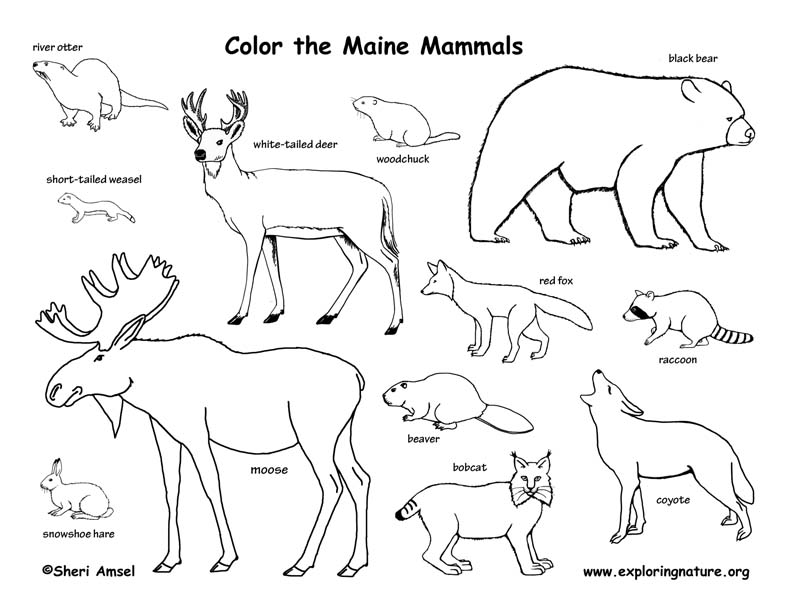

Forest
As with much of the northeast, Maine was mostly forested until European settlers cleared more than a third of the state for farming (mostly the southern part of the state). A migration westward to milder climates in the late 1800s allowed the forests to recover starting with white pines which became the most common conifer in the southern part of the state.
• Maine's forests are very diverse with Spruce - Fir - Northern Hardwoods Forests over most of the northern half of the state.
• Southern Maine has the Central Hardwoods Oak Forests.
• A narrow belt of coniferous forest along the coastline make up the Maritime Forest.
• White Pine - Mixed Hardwoods Forests lie between the deciduous forests of southern Maine and the spruce-fir or northern hardwood forests of northern Maine - so are called Transitional Forest.
• Pine Barrens can be found around the state with pitch pine in the southwestern Maine barrens, red or white pine in the eastern Maine blueberry barrens, and spruce in far northwestern Maine.
• In southern Maine, along the Atlantic coastal plain are Coastal Plain Basin Swamps.
Wetlands
Maine has a wide variety of wetlands that are freshwater, salt water and in between – brackish.
Maine's coastal wetlands consist of salt marshes or brackish (slightly salty) marshes. Both have plants and animals that are adapted to the rise and fall of the tides (tide action) and to a salty environment. Salt marsh plants include smooth cordgrass, salt hay cordgrass, salt grass, salt marsh bulrush, glasswort, black grass, baltic rush, salt marsh sedge, and seaside arrow-grass. The less salty, brackish marshes have narrow-leaf cattails, common reeds, seaside goldenrod, and prairie cordgrass, to name a few.
Maine's freshwater wetlands are further inland and include swamps, marshes, and bogs.
Some freshwater marshes may still be affected by tide action though can grow freshwater plants adapted to the change in water levels, like wild rice, cattails, etc. The further inland you go though, the less marshes are affected by tidal action.
Inland freshwater marshes are not subject to tides rising and falling at all. Here the common wetland plants grow like: cattails, sedges, reed canary grass, bulrushes, pickerelweed, arrowhead, giant bur-reed, wild rice, water lily, horsetails, and beggars-ticks.
Wet meadows are very wet for part or most of the year with plants and shrubs that tolerate "wet feet" like steeplebush, meadowsweet, willows, and speckled alder.
Shrub swamps have more woody shrubs like red osier dogwood, silky dogwood, highbush blueberry, willows, and common winterberry that never grow more than 20-feet tall. Around them on the swamp floor grow ferns, asters, and skunk cabbage.
Generally, swamps are characterized by trees (as opposed to marshes and bogs). There are both deciduous forest swamps and evergreen swamps in Maine. The deciduous swamps have red maple, larch, ash, yellow and gray birch, and American elm with some white pines throughout. Around them on the swamp floor grow shrubs like highbush blueberry, sheep laurel, chokeberry, mountain holly, elderberry, and dogwood and plants like skunk cabbage, jack-in-the-pulpit, and ferns. These swamps can be dense and difficult to explore.
Evergreen swamps have white cedar, hemlock, balsam fir, larch, and black spruce with some red maple mixed in. On the swamp floor, shrubs, ferns, and shade-tolerant wildflowers grow.
Fens are mineral-rich peatlands that develop where springs seep out of the ground and along rivers and streams. Wooded fens grow mostly larch and northern white cedar with fewer red maple and black spruce. At ground level, chokeberry, sweet gale, blue flag, and skunk cabbage grow. There are treeless fens with sedges, cottongrasses, beak-rush, peat mosses, and liverworts – called herbaceous fens.
Peat Bogs are wet year round and tend to be nutrient poor. They grow shrubs like leatherleaf, sheep and bog laurel, labrador tea, huckleberry, and cranberries and plants like white-fringed orchids, cotton-grasses, and bog goldenrod. There may also be insectivorous sundews and pitcher-plants. Forested bogs have black spruce, balsam fir, and larch as well.
Alpine
Maine has mountain top alpine habitats that are above treeline (above 3500'). These extreme habitats have only low and often sparse vegetation due to the harsh environment. Low mats of dwarfed alpine shrubs like alpine bilberry, mountain-heath, diapensia, Labrador tea, and crowberry. These habitats are so fragile that hikers are asked to stay on paths and rocks and not tread on the plant-life.
For more information about Maine Habitats go to: LINK
Land Mammals
Ocean Mammals:
For more information about Maine's mammals (including Latin names) click on individual animal links or for another resource: LINK
Amphibians
Reptiles
For more information about Maine's amphibians and reptiles (including Latin names) click on individual animal links or for another resource: LINK
When you research information you must cite the reference. Citing for websites is different from citing from books, magazines and periodicals. The style of citing shown here is from the MLA Style Citations (Modern Language Association).
When citing a WEBSITE the general format is as follows.
Author Last Name, First Name(s). "Title: Subtitle of Part of Web Page, if appropriate." Title: Subtitle: Section of Page if appropriate. Sponsoring/Publishing Agency, If Given. Additional significant descriptive information. Date of Electronic Publication or other Date, such as Last Updated. Day Month Year of access < URL >.
Amsel, Sheri. "Maine Habitats, Mammals, Birds, Amphibians, Reptiles" Exploring Nature Educational Resource ©2005-2024. December 13, 2024
< http://www.exploringnature.org/db/view/Maine-Habitats-Mammals-Birds-Amphibians-Reptiles >








